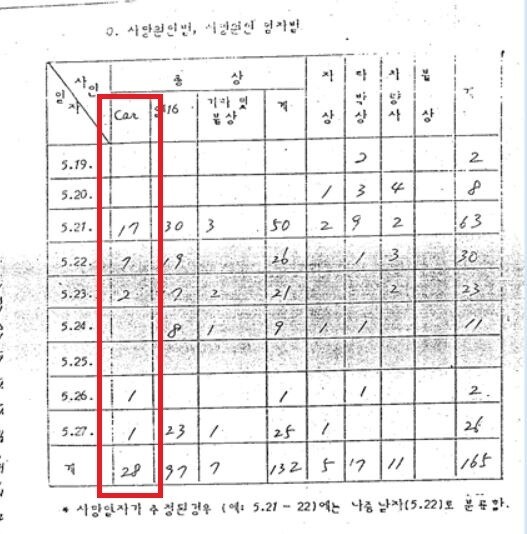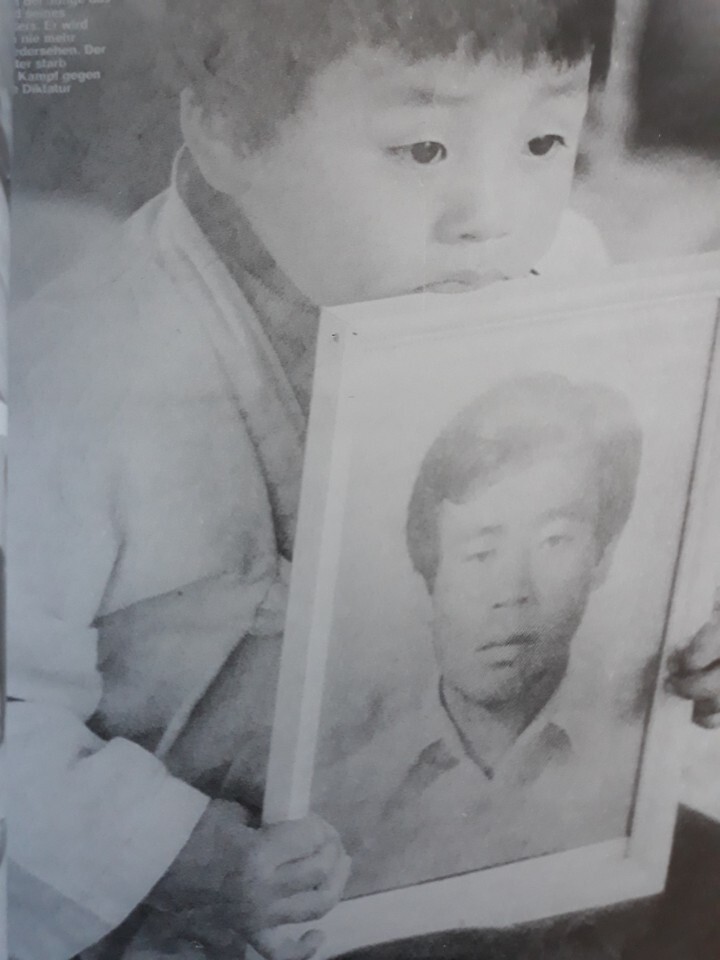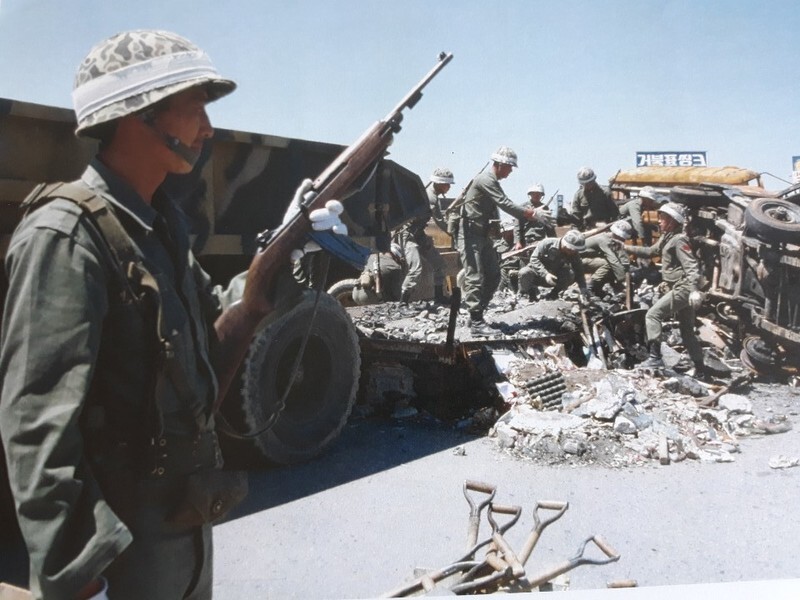hankyoreh
Links to other country sites 다른 나라 사이트 링크
Post mortem doctor says only 1 civilian victim killed by friendly fire during Gwangju Movement

A doctor in charge of post mortem examinations during the Gwangju Democratization Movement in 1980 has come forward to say that only one of the Gwangju citizens who died in the uprising was killed by rounds from an M1 carbine. This testimony supports the allegation that the military junta under ex-president Chun Doo-hwan concocted reports that a substantial number of the dead had been shot by an M1, which was used by Gwangju citizens, in order to downplay the martial law troops’ role in the massacre. Officials from the Fifth Republic (Chun regime) have claimed that between 28 and 88 of the citizens killed in the uprising were shot by an M1, supposedly during friendly fire by citizens or during operations by North Korean units.

“In the initial post mortem reports in the movement, only one of 164 citizen fatalities was attributed to gunshot wounds from an M1,” said Mun Hyeong-bae, a former professor at the medical college at Wonkwang University, during an interview with the Hankyoreh on May 16. Mun, who was a doctor at Chonnam National University Hospital at the time, was one of two doctors on an ad hoc post mortem committee consisting of 11 people from various fields. Park Gyu-ho, a former professor at the medical school at Chosun University, is no longer alive, leaving Mun as the only surviving doctor from the post mortem committee. The members of the post mortem committee drafted final reports based on preliminary reports prepared by 49 examiners, including prosecutors, police, and doctors.
The doctors who took part in the post mortems only recorded the physical appearance of the entrance and exit wounds, that is, where the bullets went into and came out of the bodies. Gunshot wounds from an M16 are normally larger at the exit than at the entrance, while wounds from an M1 are much the same at the entrance and exit. “It’s impossible to make an accurate categorization until you’ve seen the actual bullet. But the reason I remember there was one fatality caused by an M1 is because the police officers gave us comparatively accurate information about how they had died,” Mun said.

On Aug. 19, 1980, the Gwangju District Office of the Prosecutors reported that 164 citizens had been killed in the movement. According to the prosecutors, 135 of them had been killed by gunshot wounds, 28 of which were inflicted by an M1. The number of people reportedly killed by an M1 gradually increased in subsequent years. In Oct. 1985, the prime minister told the National Assembly that the number had risen to 37, and in February 1988, So Jun-yeol, former commander of the Combat Education Command, raised it still further to 88.
“Since the citizens armed themselves with M1 carbines after the martial law troops opened fire on May 21, there’s a strong likelihood that the government boosted the number of people it reported killed by M1 carbines to make it look like the armed citizens had been killed by friendly fire,” said Jeong Su-man, former chair of a group representing families of those killed in the movement.

According to Mun, the false claim that these citizens had been killed by an M1 began with an attempt to sort out the “rioters” by the 505 DSC Unit (DSC Gwangju branch), attached to the Defense Security Command. “After the post mortem reports were released, the 505 DSC Unit got to work on separating the “rioters” from other civilians. The fact is that they tried to base this categorization on whether they were killed with an M16 or an M1,” Mun said.
The dead citizens killed by the M16s used by the martial law forces were categorized as rioters, which rendered them ineligible for government funding for their funeral expenses. This suggests that the number of victims reportedly killed by an M1 may have been inflated in an attempt to clear the victims’ reputation of having been a “rioter” or in order to secure funding for funeral expenses or other matters. The blame for the deaths of such individuals was shifted to the armed citizens.

By Jung Dae-ha, Gwangju correspondent
Please direct comments or questions to [english@hani.co.kr]

Editorial・opinion
![[Column] Park Geun-hye déjà vu in Yoon Suk-yeol [Column] Park Geun-hye déjà vu in Yoon Suk-yeol](https://flexible.img.hani.co.kr/flexible/normal/500/300/imgdb/original/2024/0424/651713945113788.jpg) [Column] Park Geun-hye déjà vu in Yoon Suk-yeol
[Column] Park Geun-hye déjà vu in Yoon Suk-yeol![[Editorial] New weight of N. Korea’s nuclear threats makes dialogue all the more urgent [Editorial] New weight of N. Korea’s nuclear threats makes dialogue all the more urgent](https://flexible.img.hani.co.kr/flexible/normal/500/300/imgdb/original/2024/0424/7317139454662664.jpg) [Editorial] New weight of N. Korea’s nuclear threats makes dialogue all the more urgent
[Editorial] New weight of N. Korea’s nuclear threats makes dialogue all the more urgent- [Guest essay] The real reason Korea’s new right wants to dub Rhee a founding father
- [Column] ‘Choson’: Is it time we start referring to N. Korea in its own terms?
- [Editorial] Japan’s rewriting of history with Korea has gone too far
- [Column] The president’s questionable capacity for dialogue
- [Column] Are chaebol firms just pizza pies for families to divvy up as they please?
- [Column] Has Korea, too, crossed the Rubicon on China?
- [Correspondent’s column] In Japan’s alliance with US, echoes of its past alliances with UK
- [Editorial] Does Yoon think the Korean public is wrong?
Most viewed articles
- 1‘We must say no’: Seoul defense chief on Korean, USFK involvement in hypothetical Taiwan crisis
- 2N. Korean delegation’s trip to Iran shows how Pyongyang is leveraging ties with Moscow
- 346% of cases of violence against women in Korea perpetrated by intimate partner, study finds
- 4[Column] Park Geun-hye déjà vu in Yoon Suk-yeol
- 5‘Weddingflation’ breaks the bank for Korean couples-to-be
- 6Will NewJeans end up collateral damage in internal feud at K-pop juggernaut Hybe?
- 7Amnesty notes ‘erosion’ of freedom of expression in Korea in annual human rights report
- 8[Interview] Dear Korean men, It’s OK to admit you’re not always strong
- 9Korean government’s compromise plan for medical reform swiftly rejected by doctors
- 10[Editorial] Japan’s rewriting of history with Korea has gone too far